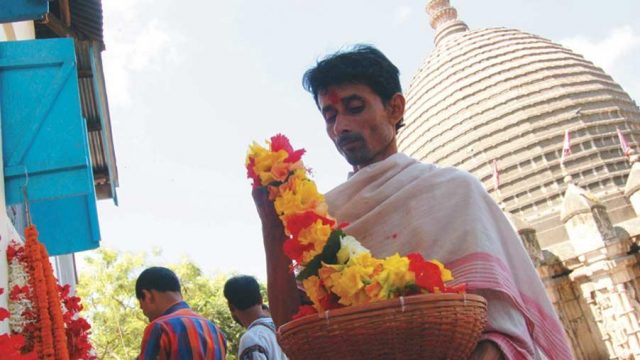“Om Kamakshaye namah!” intones Jitendra Sarma as he takes yet another devotee through the rituals inside the sanctum sanctorum of Guwahati’s Kamakhya temple. In the moist, hot darkness, devotees file past reverentially. Floral offerings are hurriedly made, ghee lamps lit, and prasad offered, even as Jitendra applies vermillion tikas to the foreheads of the devotees, and asks them to repeat some formulaic Sanskrit mantras after him. At 45, Jitendra is a traditional barapujari of the Kamakhya temple, well versed in the temple’s rituals. He is fluent in English, Hindi and Assamese and in tune with the times, as borne out by his mobile phone, which rings constantly. Over 5,000 devotees visit the Kamakhya temple daily, and as a barapujari, Jitendra scarcely has time to grab a bite as he shepherds the throngs.
Jitendra’s day begins early. After his morning bath and a cup of tea, he dons his red dhoti and gamcha and sets out for the temple, a five-minute walk from his residence on Nilachal hill. The temple doors open to the public at 7am though the queue starts forming an hour earlier. Jitendra is not on duty inside the sanctum sanctorum every day, only when his turn comes in accordance with the pali or roster. On duty days he heads straight inside, bowing to Lord Ganesha on the way. The sanctum has already been swept clean and Jitendra, along with the other barapujaris, applies vermillion to the yonipitha of Kamakhya and lights the large oil lamps.
With sweat pouring down his limbs in the sweltering heat and the pressing crowds eager to make their offerings, Jitendra manages to last in the seemingly claustrophobic atmosphere till 1pm when the temple doors close for lunch. He then heads home for a quick meal and returns by 3pm. At times, he skips lunch to handle the rush. Innumerable cups of tea and quick cigarettes in the temple courtyard are his sole sustenance on those days.
The late afternoon shift is more relaxed. The rush abates and a slight breeze dissipates the heat over Nilachal hill. At around 7pm, the last of the devotees pay their obeisance to the goddess, the temple doors close for the night and Jitendra is free to go home. It is a tough grind and the strain shows in Jitendra’s lean frame. But his eyes are bright and he breaks into a smile as he explains the mythology of Kamakhya to me.
Jitendra has it a little easier on days when he is not on duty inside the sanctum sanctorum. On such days, he spends more time with his old clients, attends to his personal affairs, conducts minor pujas for items as miscellaneous as commissioning a new vehicle or buying a new house. He takes clients to the surrounding smaller temples of Bagalamukhi, Bhuvaneshavari, Kali, Tara, Bhairavi, Dhoomavati and Chinnamasta, all part of the dasa mahavidya pantheon, representing different aspects of Devi.
I learn to my surprise that the legendary tantrics of Kamakhya have all but disappeared. Since very few had disciples, their knowledge of tantra vidya died along with them. Jitendra is not a tantric or a Sanskrit scholar. He dropped out of college to follow in his father’s footsteps as a pujari. Today, he has little time or inclination for scholarship or research. However, he does maintain 25-30 ledgers containing records of the yajamans or clients of his family since his grandfather’s days.
Jitendra has his own modest three-room house close to the temple where he lives with his wife and daughter. His elderly father is semi-retired and lives close by. Occasionally, the family eats mutton, chicken, fish and eggs. The mutton comes from the goats that are sacrificed to the goddess, although a pujari gets his share only once or twice a month. The family’s landholdings in the village, which are leased out to cultivators on a sharecropping basis, provide sufficient rice for eight months in a year.
Jitendra has managed to have his daughter educated in an English medium school and is going to send her to a professional training institute to become an airhostess. As for himself, he is content living on Nilachal hill and being a pujari of the goddess Kamakhya for the rest of his days. The goddess will take care of his needs, he affirms. His unflinching faith and devotion make me smile as I flit from temple to temple behind him, picking my way gingerly on the gravelled paths and oily stone steps.
Assam: A Day in The Life of A Priest at Kamakhya Temple
For a priest at the famed Kamakhya temple in Guwahati, Assam, work is worship

Assam: A Day in The Life of A Priest at Kamakhya Temple
Assam: A Day in The Life of A Priest at Kamakhya Temple



